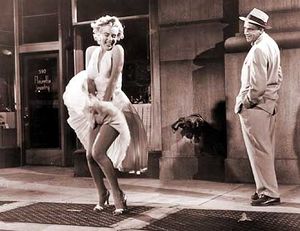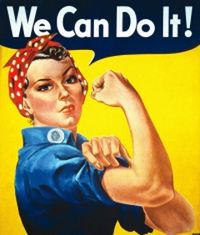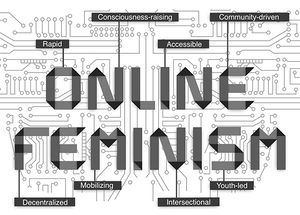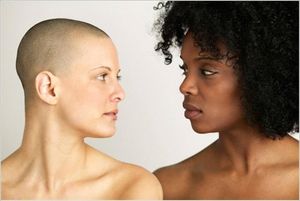Brief History of the Feminism Movement
| The feminism act is described through several waves of history. The first and second waves are the beginning of this movement. These waves mark the origination of questioning previous oppressions by the male-dominated society.[1] The main focus of these two waves was achieving equality for women and minority groups, such as suffrage, sexuality and reproductive rights.[2] The third wave started in the 80’s and was guided by Cherrie Moraga, Gloria Anzaldua, bell hooks, Chela Sandoval, Audre Lorde, Maxine Hong Kingston and many other feminists. In the third wave, feminists started to fight back against culturally and socially constructed binaries.[3]Also, "In this phase many constructs were destabilized, including the notions of "universal womanhood," body, gender, sexuality and heteronormativity".[2] |
|
Fourth Wave of Feminism
| Women activists believe that the fourth wave of feminism is shaped by the online social media which is emerging in the contemporary setting. The emergence of the Internet and Web 2.0 enabled women to develop their femininity and raise their voices by using online tools and social media [4]. The most important roles of social media are constituting agency and providing tools to represent women's identity. These features provide women activists a flexible field to open new discussions, criticize issues and distribute their knowledge amongst other social media members[5]. Participating in social media with the freedom of choice empowers women to represent femininity without being forced to follow the man-made criteria and structures. |
|
Benefits of Using Social Media
bell hooks believes that minorities should use any available tool to open up the possibility of the agency to confront, resist and change the circumstances of domination. She believes that minority groups have been subjected to the Dominating Gaze and they need to fight back in order to confront it and interrogate the gaze of others and look back. In her Black looks. Race and representation, bell hooks proposes one needs to "assert agency by claiming and cultivating 'awareness', [politicizing the] 'looking' relations [and learning] to look a certain way in order to resist". As a solution, she coins the term "Oppositional Gaze".[6]
Also, social media helps women to develop their agency by voicing their concerns and taking actions. In addition, social media equips feminist activists with a new tool in order to represent their femininity without subjecting it to the Male Gaze.
Oppositional Gaze
| According to bell hooks, Oppositional Gaze is a critical look that monitors and reinterprets the structures of a societal Behaviours. She relies on an example from her childhood when she has been questioned by adults because of staring into their eyes and later punished as a disrespectful girl for not looking back when being talked to. She basically positions the act of looking as confrontational, "as [a] gesture of resistance [that] challenges authority".[6]
|
|
Agency
The “realized capacity of people to act effectively upon their world and not only to know about or give personal or intersubjective significance to it. That capacity is the power of people to act purposively and reflectively, in more or less complex inter-relationship with one another, to reiterate and remake the world in which they live, in circumstances where they may consider different courses of action possible and desirable, though not necessarily from the same point of view.[7]
Representation
| Stuart Hall defines the representation as a process which produces a meaning and exchanges it for members of a group or society through using language, signs, and images to describe and represent things.[8] . As an example, “The letters T,R,E,E, do not look anything like trees in Nature, nor does the word 'tree' in English sound like 'real' trees (if indeed they make any sound at all!). The relationship in these systems of representation between the sign, the concept and the object to which they might be used to refer is entirely arbitrary. By 'arbitrary' we mean that in principle any collection of letters or any sound in any order would do the trick equally well. Rees would not mind if we used the word SEERT — 'trees' written backwards — to represent the concept of them. This is clear from the fact that, in French, quite different letters and a quite different sound is used to refer to what, to all appearances, is the same thing — a 'real' tree — and, as far as we can tell, to the same concept — a large plant that grows in nature. The French and English seem to be using the same concept. But the concept which in English is represented by the word, TREE, is represented in French by the word, ARBRE.”[9]
|
Critiques of the Social Media
| There are current critics about the role of media in perpetuating existing gender inequalities that can be extended to social media such as Laura Mulvey and Rosalind Hill critics. According to Laura Mulvey, “in a world ordered by sexual imbalance, pleasure in looking has been split between [the] active/male and passive/female. This speaks to the power imbalance present and perpetuated in different forms of media that separates the woman as passive and dominated, from the man as dominant.[10]
|
 "Woman as Image, Man as Bearer of the Look" |
Post-Feminism Critic
In ‘Postfeminist Media Culture’, Gill talks about a male gaze as a gaze that is not forced upon its subjects but rather internalized by them to “form a new disciplinary regime [where] power is not imposed from above or the outside, but constructs [a female] very subjectivity.” As Gill puts it, “Girls and women are invited to become a particular kind of self, and are endowed with an agency on condition that it is used to construct oneself as a subject closely resembling the heterosexual male fantasy found in pornography.”[11]
Refrences
- ↑ Cowman, Krista (2010): ‘Carrying on a Long Tradition’. In European Journal of Women's Studies 17 (3), pp. 193–210. DOI: 10.1177/1350506810368909.
- ↑ 2.0 2.1 [1],Martha Rampton (October/25/2015): Four Waves of Feminism | Pacific University
- ↑ [2],Kinser, Amber E. (2004): Negotiating Spaces For/Through Third-Wave Feminism. In NWSA Journal 16 (3), pp. 124–153
- ↑ Nally, Claire; Smith, Angela: Twenty-first century feminism. Forming and performing femininity / edited by Claire Nally, Angela Smith.
- ↑ [3] How social media is changing the feminist movement, Nisha Chittal (2017): updated on 4/7/2017, checked on 4/10/2017.
- ↑ 6.0 6.1 Hooks, Bell (2015): Black looks. Race and representation. 1. publ. New York, NY: Routledge.
- ↑ [4],Inden, Ronald (2000): Imagining India. [ACLS Humanities E-Book edition]. Bloomington, Ind.: Indiana University Press.
- ↑ Hall, Stuart (1997): Representation. Cultural representations and signifying practices / edited by Stuart
- ↑ Hall. London: Sage in association with the Open University (Culture, media, and identities, bk.2).
- ↑ Mulvey, Laura. “Visual Pleasure and Narrative Cinema.” Film Theory and Criticism : Introductory Readings. Eds. Leo Braudy and Marshall Cohen. New York: Oxford UP, 1999: 833-44.
- ↑ Gill, Rosalind (2007): Postfeminist media culture. In European Journal of Cultural Studies 10 (2), pp. 147–166. DOI: 10.1177/1367549407075898.



